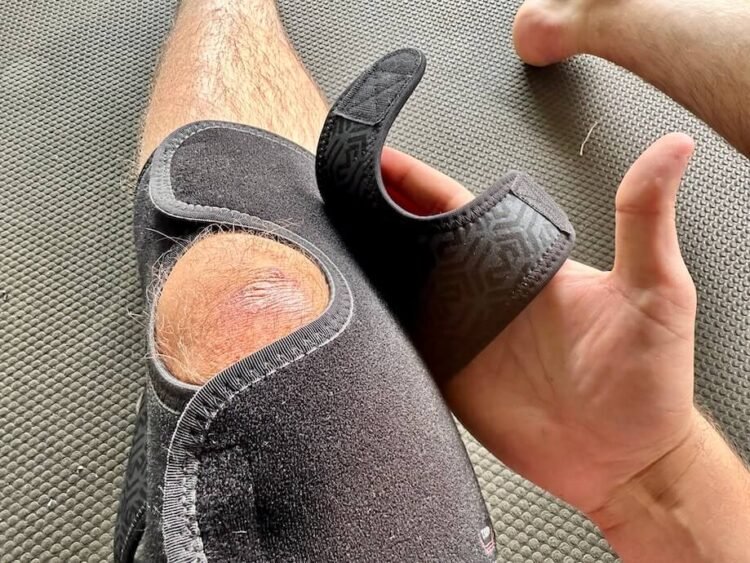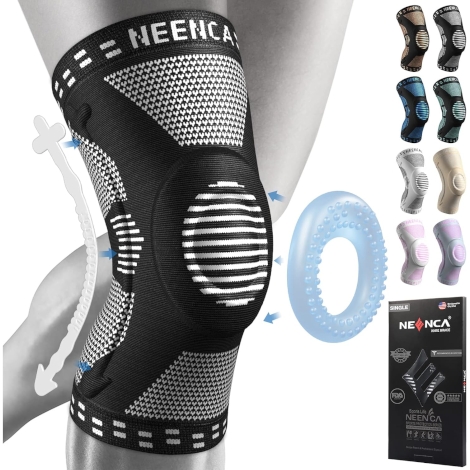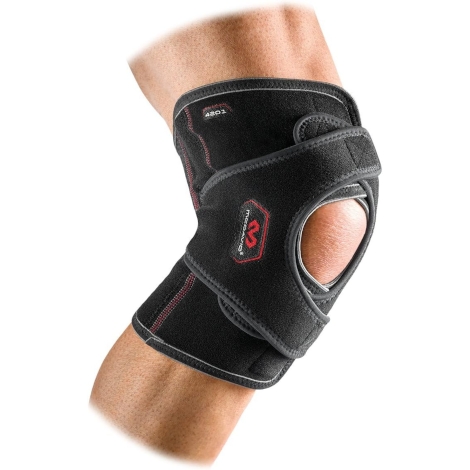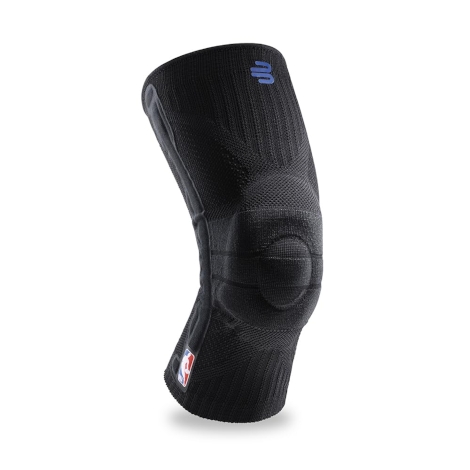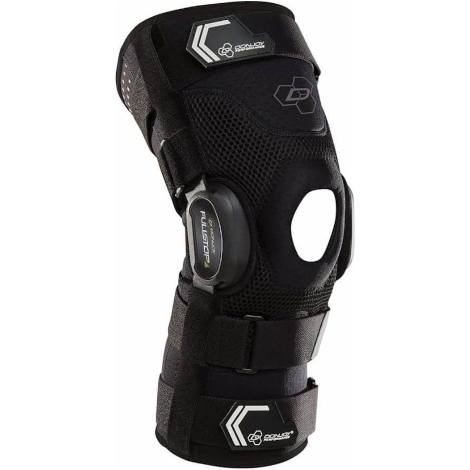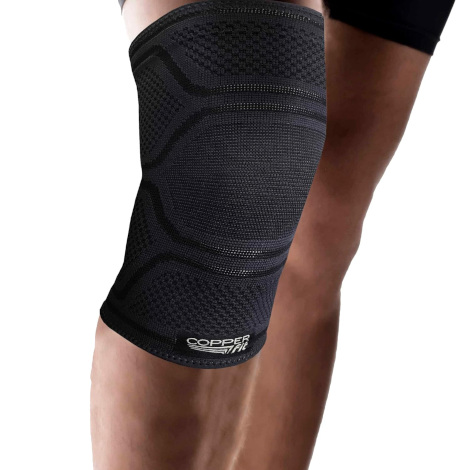We test and review fitness products based on an independent, multi-point methodology. If you use our links to purchase something, we may earn a commission. Read our disclosures.

Whether you’re a competitive weightlifter or a casual gym-goer, chances are you’ve dealt with knee pain before. As a lifelong athlete, I’ve endured the dreaded patellofemoral pain syndrome (also known as runner’s knee), sprained my medial collateral ligament (MCL) while playing college rugby, and experienced other minor knee problems that forced me to look into different joint support options.
Just like the best ankle braces can help prevent injuries, enhance your stability, and boost your confidence, the best knee braces can also provide a physical and mental lift. However, determining which type of knee brace you need can depend on a number of factors, including your underlying condition or injury (such as a torn meniscus, knee arthritis, or patellar tracking issues), the level of pain or instability, and the type of physical activity you want to engage in. To help you find the ideal fit, the Garage Gym Reviews team researched and tested a variety of braces, using our fitness equipment testing methodology to rate and examine each option in categories such as:
- Materials
- Sizing
- Adjustability
- Ergonomics
- Maintenance and upkeep
- Value
So, whether you’re searching for post-surgery support or something to make daily activities a little more bearable, we’ve got you (and your knee) covered.
Medical disclaimer: This article is intended for educational and informational purposes only. It is not intended as a substitute for medical advice. For health advice, contact a licensed healthcare provider.
The 5 Best Knee Braces
Best Overall Knee Brace: Neenca Professional Knee Brace
Good for: Providing stable support and pain relief for sports, recovery, and everyday activities
NEENCA Professional Knee Brace
Pros
Cons
The NEENCA Professional Knee Brace blends compression, stability, and comfort in an accessible design for recovery and daily wear. With patella and lateral support built-in, it’s ideal for mild injuries, chronic pain, or joint reinforcement during exercise.
Best Knee Brace for Daily Activities: McDavid Versatile Knee Wrap
Good for: Folks looking for an adjustable knee brace that offers light to moderate daily support
McDavid Versatile Knee Wrap
Pros
Cons
The McDavid Versatile Knee Wrap is an affordable, user-friendly option for those seeking light support and customizable compression. It’s great for daily wear or low-impact training but lacks the structure for intense or injury-focused use.
Best Knee Brace for Sports: Bauerfeind Sport Knee Support
Good for: Athletes and active individuals seeking reliable knee stabilization and support during high-impact sports or intense training
Bauerfeind Sport Knee Support
Pros
Cons
The Bauerfeind Sport Knee Support blends targeted compression, breathable comfort, and anatomical shaping to stabilize and protect your knee through high-performance workouts. It’s a premium option for athletes serious about knee health and function.
Best Knee Brace for Torn Meniscus: DonJoy Performance Bionic
Good for: Individuals recovering from a torn meniscus or significant knee injury who need strong lateral support and stability
DonJoy Performance Bionic
Pros
Cons
The DonJoy Performance Bionic FullStop is engineered for athletes needing serious ACL protection. With premium hinge tech and strong compression, it’s a top-tier pick for anyone recovering from or preventing ligament injuries during high-impact sports.
Best Knee Brace for Arthritis: JIUFENTIAN Copper Knee Brace
Good for: Providing targeting compression and joint support to help manage arthritis pain and inflammation
JIUFENTIAN Copper Knee Brace
Pros
Cons
The JIUFENTIAN Copper Knee Brace provides basic support and comfort for everyday activity. With copper-infused fabric and mild compression, it’s a solid choice for users seeking odor control, mobility, and light joint support on a budget.
Other Knee Braces We Researched
While we narrowed down our list to the five best knee braces, here are some other options we examined during our vetting process:
- Dr. Brace Elite Knee Brace with Side Stabilizers & Patella Gel Pads: A solid budget-friendly option, but we’d rather spend a bit more and get better quality with the McDavid Versatile Knee Wrap.
- Bauerfeind GenuTrain: While we like the features on this brace, we felt the Bauerfeind Sport Knee Support was a better choice since it’s specifically designed for athletes.
- OA Unloader Knee Brace: Designed for people with osteoarthritis, this high-level support brace received too many mixed reviews for a product with such a high price tag of roughly $120.
How We Picked and Tested the Best Knee Braces
Because knee problems can vary greatly from minor soreness to a torn patellar tendon or ACL, we conducted an all-encompassing search to find different types of braces for different uses. Although they might look straightforward, subtle design features can distinguish the best knee braces from ones that fall short in providing adequate support.
With many styles available—ranging from knee compression sleeves to hinged knee braces—we evaluated each model across several key categories. Every brace we tested received a score from 1 (lowest) to 5 (highest) across various factors to give specific context to its strengths and weaknesses.

Here’s a complete breakdown of how we assessed the best knee braces:
- Value: Does the brace provide adequate support, comfort, and durability for the price? While compression sleeves can cost around $20 to $30, more advanced hinged or stabilizing models may cost upwards of $60 or more. We evaluated whether the materials and performance justified the price tag.
- Materials: What is the brace made of, and how does it feel against your skin while in use? Common moisture-wicking materials like neoprene, copper-infused fabric, and spandex blends were assessed for comfort, breathability, and durability. We assigned lower scores to braces that lacked airflow, caused skin irritation, or didn’t feel like they were of sufficient quality.
- Sizing: Does the brace fit well without overly restricting your mobility? Improper sizing can result in inadequate support, so we evaluated whether the sizing recommendations aligned with the actual dimensions and fit we experienced. Each of our top picks also offered multiple size options and provided clear, detailed measurement guides to help ensure a comfortable fit.
- Adjustability: Can you achieve a customized fit using straps, hinges, or wraparound systems? Depending on the mechanism, we assessed how easy it was to tighten or loosen the brace.
- Ergonomics: A well-designed knee brace should contour to the natural bend of your knee joint without significantly limiting your range of motion. On the other hand, poorly designed braces can often lack key features like side stabilizers, open patella designs, and compression zones designed to enhance their comfort and effectiveness.
- Maintenance and upkeep: Is the brace easy to clean and maintain? Can you put it in the washing machine, or does it require handwashing? We also noted how well the brace held up after multiple uses. Signs of Velcro fraying, fabric pilling, or elastic becoming overly stretched out resulted in lower durability scores.
- Experience: From back squats and runs to kettlebell HIIT workouts and daily walks, we learned how each knee brace performed in different conditions. We carefully evaluated performance factors like slippage, comfort, and overall support. Braces that shifted during movement or bunched behind the knee received lower scores than ones that stayed firmly in place during workouts or everyday activities.
Benefits of Knee Braces
Safety and stability are the two words that come to mind with knee braces. In some cases, you need a brace to safely return to training. In all cases, you want to have a stable knee joint that can handle lifting, cutting, jumping, sprinting, or whatever else your activities entail.
Let’s dive into some of the physical and mental benefits of donning a knee brace.
May Prevent Knee Injuries
Whether you’re a lifter, runner, or someone who likes to stay active, exposing your knee joint to repetitive stress can increase the likelihood of injury. The risk only increases if you have muscle imbalances, poor movement mechanics, or mobility issues. Knee braces—particularly those with compression or stabilizing features—can help limit excessive joint movement and provide external support during activities.
According to a 2018 study in The Knee3, wearing a brace or sleeve during drop jump tasks reduced the knee joint’s maximum flexion, abduction angles, and adduction moment. The researchers concluded that, “If a sports knee brace that controls the knee joint’s shear force and internal rotation moment is developed, it may aid in preventing ACL injuries.”
Enhanced Joint Stability
People recovering from ACL, MCL, or meniscus injuries often experience joint instability that can make otherwise ordinary movements feel risky or imbalanced. Hinged knee braces, in particular, can provide rigid lateral support that can help prevent the knee from shifting out of alignment.

A 2019 study in Arthritis Care and Research4 on patients with knee osteoarthritis found that wearing a soft knee brace not only decreased pain but also reduced dynamic knee instability.
May Improve Proprioception
Knee braces may enhance proprioception5—your awareness of your body’s position in space. For example, compression-based knee braces stimulate your skin and soft tissues, which may help you stay more aware of your knee alignment during movements. This is especially important if you’ve had surgery or are recovering from a major ligament injury, as your proprioception may be reduced.
Can Help Relieve Pain
One of the primary reasons people wear knee braces is to reduce pain. Applying targeted compression around the knee can improve circulation, reduce joint stiffness, and decrease swelling, especially after exercise or intense activities.
According to a 2022 study in the Journal of Rehabilitation Medicine6 on patients with osteoarthritis, 54% of respondents reported a reduction in pain symptoms after wearing a semi-rigid knee brace for three weeks. In addition, 62% reported an overall improvement in daily functioning while using a knee brace.
May Boost Confidence
Just like wearing the best weightlifting belt can give you added peace of mind before you bang out a set of squats, wearing a knee brace can boost your confidence during exercise or sports—especially if you’ve had previous knee injuries.
As a longtime rugby player who suffered his fair share of bumps and bruises, I’ll admit the psychological impact of an injury can linger long after you’ve physically healed. For many people who’ve suffered a knee injury, a brace can provide some mental reassurance that your joint is protected.

This is supported by a 2020 randomized control trial7 that examined the impact of wearing a knee brace on people with patellofemoral pain dealing with self-reported kinesiophobia—a debilitating fear of movement. In both two- and six-week interventions, the knee brace improved kinesiophobia immediately, suggesting a brace can help curb some of those mental hurdles.
Buying Guide: What to Look for in Knee Braces
Whether you’re managing a chronic knee condition, recovering from a ligament injury, or simply want to stay safe during sports or training sessions, choosing the right knee brace can have a major impact on your performance, comfort, and overall joint health. Here are some key factors to consider as you explore your bracing options:
Type of Support
Not all knee braces are designed for the same purpose. Some are meant to prevent injury during athletic activity, such as the hinged braces you often see donned by some football linemen. Others are primarily designed for post-injury recovery or to help manage chronic conditions like knee arthritis. Here’s a quick rundown of the main types of knee braces:
- Compression sleeves like the Neenca Professional are great for general support, minor swelling, or everyday use.
- Hinged braces like the DonJoy Performance Bionic provide more rigid support for common ligament injuries like ACL or MCL tears.
- Wraparound or adjustable braces like the McDavid Knee Wrap can provide flexible, customized support for sports, intense workouts, or even daily activities.
Level of Compression and Stability
While compression helps with circulation, swelling, and muscle recovery, stability reduces strain on the knee joint. Depending on your injury or condition, you want to strike the right balance of compression and stability. We recommend braces with compression zones that support the patella (kneecap) and surrounding tendons, especially if you have a history of knee problems.

Furthermore, braces with side stabilizers reinforce that lateral protection while giving you more control and confidence. If you’re coming off surgery or suffer from major knee instability issues, look for a brace with bilateral hinges to prevent excessive side-to-side motion.
Fit and Adjustability
Just like the best knee sleeves fit snugly without being too restrictive, so do the best knee braces. In addition to multiple size options, go for braces that have adjustable straps (hook-and-loop, Velcro, or figure-eight styles) that allow you to tailor the tightness based on your activity. Some braces also have silicone strips that prevent them from bunching or sliding.

You should also consider whether you’ll wear the brace only during workouts or throughout the day. If it’s the latter scenario, make sure it fits comfortably with whatever you’re wearing, as you may have to fit the brace under your clothes.
“Unless a specialist says to continue using the brace constantly, taking off the brace is recommended because bracing can put a lot of pressure on a person’s skin,” says Dr. Jonathan H. Shaw, an orthopedic surgeon and hip and knee specialist.
Material and Breathability
If you plan to wear a brace for hours, it better be comfy. Prioritize materials that balance support with breathability. Neoprene and nylon blends can offer firm compression, a light stretch, and solid durability. Copper-infused or mesh materials have moisture-wicking properties that can help reduce odors, making them ideal for daily wear. Overall, it can be best to avoid thick, rigid fabrics unless you’re specifically recovering from a major injury and need maximum support.

While most knee braces require minimal upkeep, it’s important to clean them regularly to maintain their support and hygiene. In most cases, they should only be hand-washed and air-dried to preserve the material’s integrity.
Price and Value
Prices can range from roughly $15 for a knee strap or basic knee sleeve to more than $100 for a hinged brace designed for post-op recovery. Budget-friendly models may work well for short-term use or minor discomfort, but they may not have specialized features such as advanced compression zones or polycentric hinges needed for more advanced stability.
If you’re dealing with a chronic knee issue and plan to use the brace regularly, it would be wise to invest in a more durable option that can save you money (and headaches) in the long run—even if it’s a little pricey in the short term.
Experts Who Contributed To This Article
FAQs About the Best Knee Braces
Which is better: a knee stabilizer or knee brace?
Choosing a stabilizer versus a brace depends on the severity of your injury and the level of support you need. While knee stabilizers can provide targeted support for ligament injuries or instability, knee braces can provide broader compression and mild support for pain, swelling, or overuse.
How do I wear a knee brace?
While the exact steps may change based on the model you purchase, the best way to wear a knee brace is to place the opening (if applicable) over your kneecap, tighten the straps so they’re snug without cutting off circulation, and make sure the hinges or stabilizers (if included) align with the sides of your knee.
What is the best knee brace for running support?
Runners should look for a lightweight compression sleeve with breathable materials that stabilizes your knee joint. Hinged braces are often too bulky and can restrict your range of motion, making them a poor choice for runners in most cases.
References
- Luvsannyam, E., Jain, M. S., Leitao, A. R., Maikawa, N., & Leitao, A. E. (2022). Meniscus Tear: Pathology, Incidence, and Management. Cureus, 14(5), e25121. https://doi.org/10.7759/cureus.25121
- Richmond, S. J., Gunadasa, S., Bland, M., & MacPherson, H. (2013). Copper bracelets and magnetic wrist straps for rheumatoid arthritis – Analgesic and anti-inflammatory effects: A randomised double-blind placebo controlled crossover trial. PLoS ONE, 8(9), Article e71529. https://doi.org/10.1371/journal.pone.0071529
- Raschner, C., Luchner, R., Platzer, H.-P., Patterson, C., Huber, R., & Patterson, C. (2018). Effect of wearing a knee brace or sleeve on the knee joint and anterior cruciate ligament force during drop jumps: A clinical intervention study. The Knee, 25(6), 1007–1014. https://doi.org/10.1016/j.knee.2018.07.017
- Cudejko, T., van der Esch, M., van den Noort, J. C., Rijnhart, J. J. M., van der Leeden, M., Roorda, L. D., Lems, W., Waddington, G., Harlaar, J., & Dekker, J. (2019). Decreased Pain and Improved Dynamic Knee Instability Mediate the Beneficial Effect of Wearing a Soft Knee Brace on Activity Limitations in Patients With Knee Osteoarthritis. Arthritis care & research, 71(8), 1036–1043. https://doi.org/10.1002/acr.23722
- Han, J., Waddington, G., Adams, R., Anson, J., & Liu, Y. (2016). Assessing proprioception: A critical review of methods. Journal of sport and health science, 5(1), 80–90. https://doi.org/10.1016/j.jshs.2014.10.004
- Dries, T., Van Der Windt, J. W., Akkerman, W., Kluijtmans, M., & Janssen, R. P. A. (2022). Effects of a Sem-Rigid Knee Brace on Mobility and Pain in People With Knee Osteoarthritis. Journal of rehabilitation medicine. Clinical communications, 5, 2483. https://doi.org/10.2340/jrmcc.v5.2483
- Priore, L. B., Lack, S., Garcia, C., Azevedo, F. M., & de Oliveira Silva, D. (2020). Two Weeks of Wearing a Knee Brace Compared With Minimal Intervention on Kinesiophobia at 2 and 6 Weeks in People With Patellofemoral Pain: A Randomized Controlled Trial. Archives of physical medicine and rehabilitation, 101(4), 613–623. https://doi.org/10.1016/j.apmr.2019.10.190


